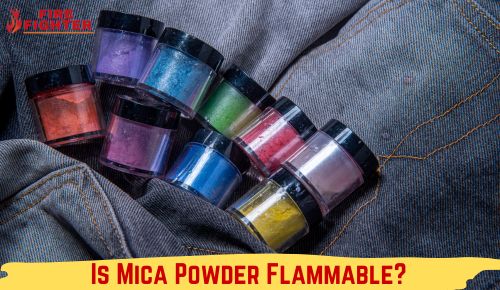Is Mica Powder Flammable? Exploding Myths
Mica powder, a popular ingredient in various industries, has been the subject of many discussions. People are curious about its properties, uses, and potential risks.
One question that frequently arises is whether mica powder is flammable. This blog post will delve into this topic and explore the facts surrounding mica powder’s flammability.
So, stay tuned to discover everything you need to know about this intriguing substance.

Contents
What Is Mica Powder?
Mica powder is a finely ground mineral substance derived from the mineral mica. Mica is a naturally occurring mineral found in various parts of the world, typically in igneous and metamorphic rocks.
It has a layered structure composed of potassium, aluminum, silicon, oxygen, and hydrogen.
Mica powder is created by grinding mica flakes or sheets into a fine powder form. It comes in many colors, including metallic shades, and has a shimmering or pearlescent appearance. The size of the mica particles determines the texture and luster of the powder.
Is Mica Powder Flammable?
When it comes to mica powder, the flammability factor becomes a concern for many individuals, particularly those working in industries with high temperatures or open flames.
The good news is that mica powder is generally considered non-flammable. This means it does not catch fire easily and does not support combustion.
The non-flammable nature of mica powder can be attributed to its unique chemical composition and physical properties. Mica consists of thin, flexible, and transparent layers that are resistant to heat.
When exposed to high temperatures, mica undergoes exfoliation, wherein the layers split apart, expanding and creating a barrier that acts as insulation against heat and flames.
This property makes mica an excellent choice for applications that require thermal resistance.
However, it is crucial to note that while mica powder may not be flammable, additives or impurities in certain mica powders could potentially affect their flammability.
Is Mica Combustible?
No, mica is generally considered non-combustible. Mica is a mineral with excellent heat resistance and does not readily burn or catch fire. It has a high melting point and can withstand high temperatures without igniting or releasing flammable gases.
This property makes mica a valuable material in applications where heat resistance is important.
It is often used as an insulating material in electrical and electronic devices, such as heating elements, where it helps to dissipate heat and prevent electrical components from overheating.
However, it’s important to note that while mica itself is non-combustible, other materials or substances combined with mica in a product may affect its overall flammability.
Is Mica Powder Toxic
Mica itself is considered non-toxic and safe for use in cosmetics. However, concern arises regarding the mining and processing of mica. In some regions where mica is mined, there have been reports of unethical practices, including child labor and unsafe working conditions.
These issues have raised concerns about the overall ethical and environmental impact of mica mining.
Various organizations and initiatives have been implemented to address these concerns and promote responsible mica sourcing.
These efforts aim to ensure that mica is mined and processed in a way that protects both the environment and the workers involved.
Is Mica Dust Dangerous
Inhaling mica dust in small quantities is not considered dangerous to health. Mica is a naturally occurring mineral, and its dust is primarily composed of fine particles of mica minerals.
These particles are generally inert and do not pose significant health risks when encountered in normal situations.
However, it’s important to note that prolonged or excessive exposure to large amounts of mica dust can potentially lead to respiratory issues.
Breathing in large quantities of fine dust particles over an extended period may irritate the respiratory system and cause lung problems, particularly in individuals with pre-existing respiratory conditions or sensitivities.
Is Mica An Explosive?
To put it simply, no, mica is not an explosive mineral. Mica is a silicate mineral commonly found in rocks and known for its unique properties. It has a layered structure, with each layer comprising sheets that can be easily separated into thin, flexible flakes.
Due to their exceptional heat resistance, electrical insulation, and optical properties, these flakes are often used in various industries, including cosmetics, electronics, and construction.
While mica is not explosive, it’s important to note that, like any mineral, it can undergo various chemical reactions under specific conditions. For example, when exposed to extremely high temperatures, mica can melt and vaporize.
This process can release gases and potentially lead to explosive conditions if the concentration of the released gases reaches certain limits.
What Are The Hazards Of Mica?
In its natural form, Mica is generally considered a low-hazard material. However, certain hazards can arise depending on specific factors, such as the type of mica, its impurities, and the context in which it is used or processed. Here are some potential hazards associated with mica:
Inhalation of Dust: When mica is processed, cut, or ground into fine particles, it can generate dust. Inhalation of large amounts of mica dust over an extended period may cause respiratory irritation or lung problems, especially in individuals with pre-existing respiratory conditions.
Impurities: Some types of mica may contain impurities or contaminants that could pose health risks. For instance, certain mica deposits may have traces of minerals like silica or asbestos. These impurities can have adverse health effects if present in significant quantities and released into the air as dust.
Skin Irritation: Direct and prolonged contact with mica powder or products containing mica may cause skin irritation in some individuals, particularly those with sensitive skin or allergies. This can manifest as redness, itching, or rash.
Occupational Hazards: Workers involved in the mining, processing, or manufacturing of mica-based products may face specific occupational hazards. These can include exposure to dust, machinery-related risks, and potential ergonomic issues if proper safety precautions and practices are not followed.
Ethical Concerns: While not a direct health hazard, it’s worth noting that mica mining has been associated with unethical practices in certain regions, including child labor and unsafe working conditions. Efforts are being made to promote responsible sourcing and ensure transparency in the mica supply chain.
What Is Mica Powder Used For?
Mica powder has a wide range of uses across various industries. Here are some common applications:
Cosmetics: Mica powder is widely used in the cosmetics industry. It is a popular ingredient in makeup products such as eyeshadows, blushes, highlighters, and foundations.
Mica adds shimmer, sparkle, and a pearlescent effect to these products, enhancing their visual appeal.
Skincare Products: Mica powder is also used in lotions, creams, and soaps. It can provide a subtle glow or shimmer to the skin when used as a cosmetic additive.
Nail Products: Mica powder is added to nail polishes, gels, and acrylic powders to create various finishes, including metallic, glitter, or holographic effects.
Crafts and Art: Mica powder is popular in arts and crafts projects. It can be used in resin art, candle making, clay modeling, and other creative endeavors to add color, shimmer, and texture to the final product.
Coatings and Paints: Mica Powder manufactures coatings, paints, and varnishes. It improves the appearance by providing pearlescent or metallic finishes and can enhance durability and heat and chemical resistance.
Plastics and Rubber: Mica powder is incorporated into plastic and rubber products to enhance the appearance and provide heat resistance and electrical insulation properties.
Ceramics: In the ceramic industry, mica powder is used as a glaze additive to create unique surface effects and improve the overall aesthetic appeal of ceramic pieces.
Electrical Insulation: Mica powder is an insulating material in electrical and electronic devices. Its excellent heat resistance and electrical insulation properties make it suitable for heating elements, capacitors, and insulating gaskets.
Conclusion
Mica powder itself is generally considered non-flammable. It is a mineral with excellent heat resistance and does not readily burn or catch fire. However, the overall flammability of a product containing mica powder can be influenced by other components or materials combined with mica.
If mica is mixed with a combustible binder or used in conjunction with flammable substances, it can contribute to the overall flammability of the product.
Therefore, when considering the flammability of a specific product, it is important to consider the entire composition and any additional flammable components present.

Hi, I m Aaron Smith, a firefighter, and creator of Firefighterline.com, a website that provides top-notch training courses for firefighting organizations. After completing my studies, I quickly rose through the fire service ranks, eventually becoming Captain at one of the busiest fire departments in the state.
